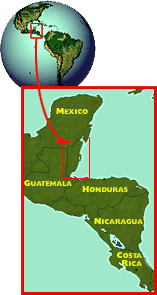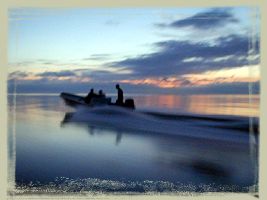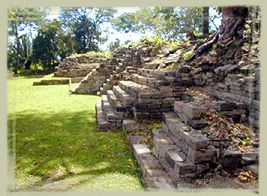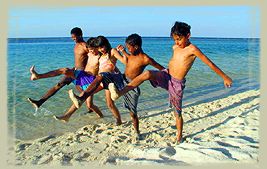
The country of Belize, lies between latitudes 15 degrees 53 minutes and 18 degrees 30 minutes north and longitudes 87 degrees 15 minutes and 89 degrees 15 minutes west. It is bounded to the north by Mexico, to the west and south by Guatemala, and to the east by the beautiful Caribbean Sea.
In form, the country is roughly rectangular, measuring 280 km from north to south and 109 km from east to west, extending to 180 km through the inclusion of the territorial sea. Total land area, including the over 1,000 offshore islands, is about 8,860 square miles, for a total national territory including the territorial sea of 18,000 square miles.
Belize is an extremely varied country for its size. Inland, the Maya Mountain range is the dominant landscape feature and rises to 3,688 feet at its highest point.

The mountains are surrounded by rugged karst limestone hills. Beyond that, most of the north of the country and the entire coastal area consists of lowlaying plains. Major rivers erode the Maya Mountains, spreading sediment onto the coastal plains and continually extending out the coastline.
Rainfall varies from less than 50 inches per year with a four month dry season in the north, to over 180 inches per year and a much shorter dry season in the south. The natural vegetation of the country reflects the varied soils and climate with over 49 distinct types of forests identified to date.

The pattern of diversity and high environmental quality of the land also applies to the coastal zone and marine waters. The Belize Barrier Reef is the largest in the western hemisphere and second largest in the world. It is, however, only part of a complex and largely intact coastal ecosystem of exceptional value.
The diversity of the marine zone is unique. Three large coral atolls lie outside the barrier reef. The continental shelf off Belize ends abruptly in a drop off that sinks to over 10,000 feet. The barrier reef runs the entire length of the country and supports a tremendous number of patch reefs, shoals and over 1,000 islands called "cayes". Most of these cayes, and the entire coastline of the country outside of settlements are protected by huge forests of mangrove.

The Mayan Civilization is among the elite of all archaic civilizations. The ancient Mayan sites of Belize cover the full spectrum of time and diversity. Belize boasts the oldest known Mayan site; the longest occupied site; and the largest carved jade object in all Mayandom.
Over 600 hundred sites have been discovered to date in Belize. New artifacts and even major sites seem to be discovered on a regular basis. And excavation projects are taking place all over Belize today. While only a fraction of the known sites are open to the public, those that are accessible will provide more than a glimpse of how spectacular this civilization was and how much a part of Belize's history it is.
In terms of government and stability, Belize is unique in Central America. It is a true democracy, which operates under the British parliamentary system. As a member of the British commonwealth, it has an excellent human rights record and freedom of the press is practiced without any censorship.

Belize has six districts. Each one has elected officials responsible for representing the people of the area. Each district has a main town which acts as the center of government for that portion of Belize. Each town has elected officials responsible for local services. Even village councils and village leaders are elected. Every citizen 18 and over can vote.
The population of Belize is very young and over 50 percent is less than 18 years old. Belize is truely a melting pot of Central America. Some of the major cultures represented in Belize include: Creole, Mayan, Garifuna, East Indian, Mennonite, Chinese and European/Mestizo.
![]()
![]()
![]()
![]()
![]()
![]()
![]()
![]()
![]()
![]()
![]()
![]()
![]()
![]()
![]()
![]()
![]()
![]()
![]()
![]()